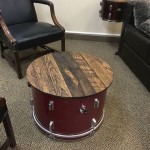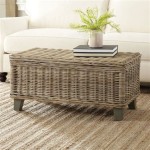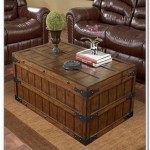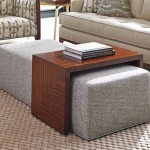Standard Coffee Table Dimensions in Centimeters
The selection of a coffee table for a living space involves careful consideration of various factors, including room size, furniture arrangement, and desired functionality. One of the most crucial aspects to evaluate is the dimensions of the coffee table, as these directly impact the table's practicality and aesthetic appeal. While standard coffee table dimensions can vary, understanding these guidelines in centimeters (cm) provides a helpful framework for making informed decisions.
The dimensions of a coffee table are typically defined by its length, width, and height. These measurements determine the table's overall size and how it fits within the existing furniture layout. In general, the goal is to select a coffee table that complements the surrounding furniture without overwhelming the space or hindering movement. A coffee table that is too large can make a room feel cramped, while one that is too small may appear insignificant and lack functionality. Therefore, adhering to established guidelines for standard coffee table dimensions in centimeters can help achieve a balanced and harmonious living area.
The consideration of standard dimensions also aids in ensuring accessibility and usability. The height of the coffee table should be appropriate for reaching items placed on it while seated on a sofa or chair. The length and width should provide sufficient surface area for placing drinks, books, remotes, or decorative objects. Moreover, the dimensions affect the flow of traffic within the room; ample space should be left around the table to allow for comfortable passage. By understanding the typical size ranges for coffee tables in centimeters, individuals can better assess how a particular model will function within their specific living space and address their needs.
Typical Length and Width Considerations
The length and width of a coffee table are primarily dictated by the size and layout of the seating area. A general rule of thumb is that the coffee table should be approximately two-thirds the length of the sofa it faces. This proportion helps to maintain visual balance and prevents the table from appearing either too small or too large in relation to the sofa. For example, if a sofa is 240 cm long, a coffee table with a length of around 160 cm would be a suitable choice. The width is then determined by the available space between the sofa and any other surrounding furniture, such as armchairs or a television stand.
Rectangular coffee tables are among the most common shapes and often range in length from 90 cm to 150 cm and in width from 45 cm to 75 cm. These dimensions provide ample surface area for a variety of uses while fitting comfortably in most living rooms. Square coffee tables, on the other hand, are often selected for smaller spaces or when placed between two chairs rather than in front of a sofa. Standard dimensions for square coffee tables typically range from 60 cm x 60 cm to 90 cm x 90 cm. These dimensions offer a compact yet functional surface for drinks, decorative items, or reading materials.
Round coffee tables are another popular option, particularly in rooms with curved furniture or a desire for softer, more organic shapes. The diameter of a round coffee table typically ranges from 75 cm to 105 cm. The choice of diameter depends on the size of the seating area and the desired proportion in relation to the surrounding furniture. Oval coffee tables offer a similar aesthetic to round tables but often provide a slightly larger surface area due to their elongated shape. The dimensions of oval coffee tables can vary, but they often range in length from 90 cm to 120 cm and in width from 60 cm to 75 cm. These dimensions provide a generous surface while maintaining a visually appealing shape.
When considering length and width, it's also important to take into account the placement of other furniture and the overall traffic flow within the room. Adequate space should be left around the coffee table to allow for comfortable passage and prevent tripping hazards. A minimum of 45 cm to 60 cm of space between the coffee table and the sofa is generally recommended. This space allows individuals to move freely around the table without bumping into it. Similarly, sufficient space should be left between the coffee table and any adjacent furniture, such as armchairs or end tables.
Ultimately, the ideal length and width of a coffee table depend on the specific characteristics of the living space and the individual preferences of the homeowner. However, by understanding the typical size ranges for different shapes in centimeters and considering the proportions in relation to the surrounding furniture, individuals can make informed decisions that result in a functional and aesthetically pleasing living area.
Importance of Coffee Table Height
The height of a coffee table is a critical dimension that affects its usability and comfort. Ideally, the height of the coffee table should be similar to the height of the sofa cushions. This allows individuals seated on the sofa to easily reach items placed on the table without having to strain or bend excessively. A coffee table that is too low can be uncomfortable to use, while one that is too high can obstruct the view and create a visually unbalanced appearance.
Standard coffee table heights typically range from 40 cm to 45 cm. This height range is generally compatible with most standard-sized sofas and chairs. However, it's important to measure the height of the sofa cushions to ensure that the coffee table is a suitable match. If the sofa cushions are particularly high or low, it may be necessary to adjust the coffee table height accordingly.
In recent years, there has been a growing trend towards taller coffee tables, sometimes referred to as "cocktail tables." These tables typically range in height from 50 cm to 60 cm and offer a more versatile surface for eating, working, or playing games. Taller coffee tables can be particularly useful in smaller living spaces where the coffee table may also serve as a dining table or workspace. However, it's important to ensure that the taller height is still comfortable for individuals seated on the sofa or chairs. If the sofa cushions are relatively low, a taller coffee table may be less practical for everyday use.
Conversely, some individuals may prefer a lower coffee table for a more relaxed and informal aesthetic. Lower coffee tables typically range in height from 30 cm to 40 cm and can create a more grounded and spacious feel in the living room. These tables are often paired with low-slung sofas or sectional couches to maintain a cohesive and comfortable seating arrangement. However, it's important to consider the practicality of a lower coffee table, as it may require individuals to bend over further to reach items placed on the surface.
Adjustable-height coffee tables offer a flexible solution for individuals who want the option to change the height of the table as needed. These tables typically feature a mechanism that allows the user to raise or lower the surface, providing a versatile platform for a variety of activities. Adjustable-height coffee tables can be particularly useful in multipurpose living spaces where the table may be used for both lounging and dining.
The height of the coffee table also affects its visual impact within the room. A coffee table that is too tall can dominate the space and obstruct the view of other furniture or decorative elements. Conversely, a coffee table that is too short may appear insignificant and lack visual presence. Therefore, it's important to consider the overall proportions of the room and the surrounding furniture when selecting the height of the coffee table. By choosing a coffee table with a height that complements the existing furniture and enhances the overall aesthetic, individuals can create a balanced and harmonious living space.
Impact of Shape on Perceived Dimensions
The shape of a coffee table significantly influences how its dimensions are perceived and how it integrates into a living space. While length, width, and height are concrete measurements, the shape can make a coffee table feel larger or smaller than its literal dimensions suggest. This perception is crucial when selecting a coffee table, as it affects both the functionality and the aesthetic balance of the room.
Rectangular coffee tables, with their defined edges and linear form, tend to maximize surface area. As previously mentioned, their length is often related to the sofa's length, while the width is determined by the available space. A rectangular table's clear lines can create a sense of order and structure in a room. However, a large rectangular table in a small space can feel overwhelming due to its pronounced presence. The corners of a rectangular table can also pose a safety concern, particularly for households with young children. Padding can be considered or opting for a rounded edge style.
Square coffee tables offer a more compact and symmetrical appearance. Their equal dimensions contribute to a balanced aesthetic, making them suitable for smaller living rooms or when placed between two armchairs. Despite having a smaller surface area compared to rectangular tables of similar overall dimensions, the square shape can still provide ample space for drinks, books, or decorative items. Similar to rectangular tables, the corners of a square table can be a potential safety hazard, but this can be mitigated by selecting models with rounded edges.
Round coffee tables introduce a softer, more organic element to a room. Their lack of corners creates a sense of flow and movement, which can be particularly beneficial in spaces with sharp angles or a more rigid design aesthetic. Because there are no corners, round tables often feel less imposing than rectangular or square tables with similar surface areas, making them a good choice for smaller or more crowded living rooms. The circular shape also promotes a more social and inclusive atmosphere, as individuals seated around the table can easily see and interact with one another.
Oval coffee tables combine the benefits of both rectangular and round shapes. Their elongated form provides a generous surface area while maintaining a softer, more fluid aesthetic. The absence of corners makes them safer than rectangular or square tables, and their curved edges contribute to a more relaxed and inviting atmosphere. Oval coffee tables can be particularly effective in rooms with a mix of straight and curved lines, as they help to bridge the gap between the two design styles.
Freeform or uniquely shaped coffee tables offer a more artistic and individualistic approach. These tables can feature asymmetrical designs, irregular edges, or unconventional materials, adding a distinctive touch to the living space. While their dimensions may vary significantly, it's important to consider how the shape interacts with the surrounding furniture and the overall flow of the room. Freeform coffee tables can be particularly effective in eclectic or bohemian-style interiors, where they serve as a focal point and add personality to the space.
In summary, the shape of a coffee table plays a crucial role in how its dimensions are perceived and how it integrates into the living space. By carefully considering the shape in relation to the size of the room, the surrounding furniture, and the desired aesthetic, individuals can select a coffee table that is both functional and visually appealing. While standard dimensions provide a helpful guideline, the unique characteristics of each shape should be taken into account to ensure a harmonious and balanced living environment.

Round 2 Coffee Table Made Of Metal Cm ø60x36h Dimensions Measurements

Coffee Table Dimensions Layout Guidelines With Photos Upgradedhome Com

Audo Copenhagen Androgyne Lounge Wood Coffee Table Natural Oak Sand Made In Design

Nyboda Coffee Table United Furniture

Clayre Eef Coffee Table Set Of 2 100 Cm 95 Brown Wood Rectangle

Furinno Simple Design Coffee Table Com

Monroe Square Coffee Table Living Room Tables Simpli Home

Vedella Side Table Naan Furniture

Liza Coffee Table Walnut Rove Concepts

Modern Coffee Table White Rectangular Living Room Minimalistic Milwaee
Related Posts








